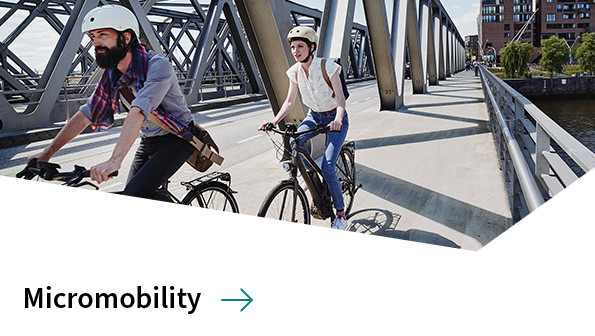
Public transportation on road and rail
Travelling sustainably in cities
Public transportation is a crucial building block in driving sustainable mobility – whether on the road or rails. It moves more people with less energy consumption per passenger, at reasonable costs, reduces congestion and noise, improves air quality and makes cities more inclusive. When based on either clean electricity or green hydrogen, public transportation with buses and trams contributes significantly to decarbonized mobility concepts. On the other hand, people want a transportation experience that let them be productive during their journeys, be independent from rigid schedules and travel when and how they want. Hence a seamless and personal mobility experience means a huge potential for smart public transportation services – from selecting the best means of transportation up to easy access to on-demand and sharing services. Infineon has the key elements to offer.
Requirements
Leveraging the potential of public transportation

Public transport service like bus, metro, tram, train are an alternative to private cars. Large cities are facing several challenges such as lack of frequent service to suburbs, long waits at transfer points, lack of a viable options to cover the “last mile” between public transport stops and people’s final destination and insufficient integration with green modes such as cycling.
The requirements for local public transport are varied. Public transportation has to become green from well to wheel, from energy generation to energy consumption. Vehicles as well as the infrastructure have to be smart to fully leverage the potential of digital traffic management and increase safety for all road users. And public transportation ultimately has to be personal by smoothly integrating the opportunities that new routing software, ticketing and payment technologies provide, in order to create a seamless mobility experience for everyone.
Ticketing and payment
Seamless payment experience thanks to interoperable ticketing services

With rapid population growth and urbanization, communities around the world are now challenged more than ever to digitalize and decarbonize their urban infrastructures, turning towards sustainable mobility. Local authorities are creating "smart cities" where citizens can digitally connect with city infrastructures to support their daily lives and to receive new, enhanced levels of convenience. This creates a significant opportunity for digital ticketing and payment in modern public transportation system.
Our products and solutions can revolutionize Public Transport

As a leading provider of smart card technology Calypso® of Infineon has become a widely adopted technology in transportation systems. Public transport authorities in countries such as France, Spain, Italy, and the Netherlands all implementing it in their systems.
Infineon's newest addition to the Calypso® product family is CALYPSO™ move, a contactless smart card technology that offers fast and secure solutions for access to and payment in public transport.
E-Bus
Getting into motion sustainably

Cities around the globe are plagued with serious challenges. One is traffic congestion, forcing buses to handle stop-and-go traffic while constantly braking and accelerating. This leads to very high carbon-dioxide and nitrogen oxide emissions. One key lever here is to turn towards electrified buses that use green energy.
Variants of electric buses
Emission-free e-buses offer cities and municipalities the opportunity to drastically reduce exhaust and noise pollution from public transportation. So far, three variants have been most common on the roads.
Battery bus with night charging: The bus battery is recharged once a day – usually overnight – using dedicated charging points in the depot.
Battery bus with opportunity charging: The battery of the bus is usually smaller than the battery of the night charger and is recharged ‘on opportunity’ during daytime operating hours, typically at terminal stops.
Fuel cell electric bus: An on-board fuel cell generates the electricity for the electric drive. The bus is refueled with hydrogen at a filling station.
Infineon semiconductors are vital in leveraging the green potential of buses
Buses must be very robust. They cover significant distances every day and achieve far greater total mileage over their service life than other vehicles: typically, more than 1,5 million kilometers compared to just up to 300,000 kilometers for a car. This all has an impact on the power electronics on board: The electronic parts have to be more robust and dependable. Infineon semiconductor solutions empower electric propulsion and help reconvert energy efficiently when braking. Also, they let manufacturers build lighter trains, contribute to higher vehicle acceleration and enable energy-efficient air conditioning, lighting and door openers. Specifically for fuel cell electric buses, Infineon provides efficient components that reduce energy loss and guarantee that the design meets the relevant regulations, standards and safety requirements.
Railways vehicles (Traction)
Increased energy-efficiency and less noise on the rails

In many urban areas, underground and suburban trains including trams make an important contribution to reduce road traffic. At the same time, they offer a favorable CO2 balance and – if they are electrically operated – are even completely emission-free. Together with regional and long-distances railways, they can drive the transformation towards decarbonized, sustainable mobility. And not only in urban areas: Trains in general make an important contribution to reducing carbon emissions. For example, one traveler on a train from Munich to Paris saves 150 kg of CO2 on a one-way trip compared to flying and arrives in the French capital in just over six hours on the fastest connection.
Infineon solutions for traction transportation prove their worth for clean mobility
Infineon covers all segments in traction transport ranging from trams and subways to regional and high-speed trains and locomotives for freight transport. Understanding today’s and future challenges, we offer a comprehensive product portfolio of best-in-class solutions allowing traction systems with the highest power density and excellent efficiency. Our components stand out because of their long lifetime and provide the reliability the traction application needs to keep on running year after year in harsh environmental conditions.
Leveraging the advantages of silicon carbide (SiC) in traction
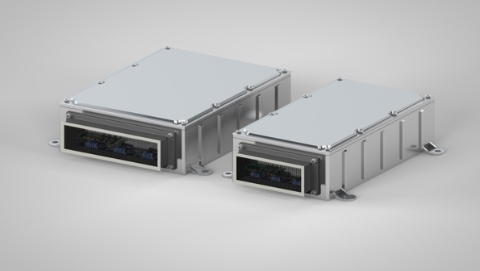
Converter size comparison, with silicon (left) and silicon carbide semiconducters (right)
In rail transport, IGBTs have dominated power electronics over the past 40 years. Silicon still dominates the market. However, new technologies are gaining traction.
Today SiC and GaN power semiconductor devices are also available in addition to silicon-based technologies. With SiC, engineers are able to achieve a higher switching frequency compared to traditional silicon-based products.
As a result, less energy is converted into heat, which leads to a more efficient system overall. This helps reduce the size of transformers, capacitors, heat sinks as well as packages saving precious space in the vehicle for more passengers.
Saving space in trains
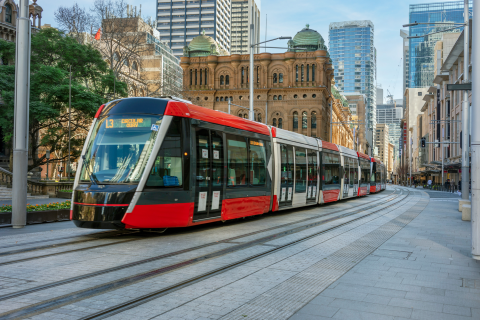
In current train models, the traction motors, power electronics and transformers are no longer located in power cars (concentrated drive), but are distributed over several cars (distributed drive). In this case, no car remains ‘unused’: Passengers can sit in every car, since the transformers and electronics as well as the traction motors are installed underfloor (or on the roof of the locomotive). However, since this uses up space, the trend is moving more and more towards more compact power electronics, such as the modular drive concept. Here, compact packages – referred to as powercars and consisting of traction motors, transformer, traction converter and the traction cooling system – are inserted between every tractionless car. This powercar concept makes it possible to vary the train length as desired, which leads to more space and seats for passengers.
Divcover more
Are you interested in the future of railways? Do you want to know how new technologies are transforming rail transportation? Then watch our Interview with Dr. Diana Car. At Infineon, we take pride in providing innovative semiconductor solutions for rail transportation worldwide. Join us and discover how we are enabling railway transportation to be more energy-efficient, safer, and smarter than ever before.
First hydrogen buses in south-east Austria to decarbonize public transport
Since August 2021, transport companies in Europe have been required to buy vehicles with alternative drives to reduce emissions.
The biggest bus operator in Austria, ÖBB Postbus, and municipal authorities in the Austrian province of Carinthia opted for hydrogen technology to start their mobility transformation. ÖBB ordered the first five hydrogen buses from Solaris hydrogen buses and will grow its hydrogen transportation fleet to 40 by 2023.
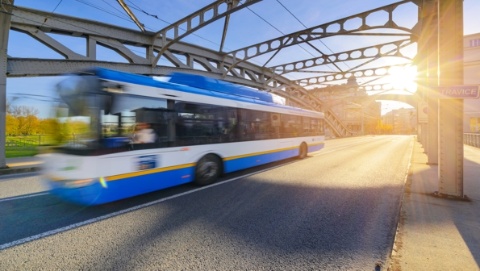
Recycled, green hydrogen for sustainable mobility
The 12-meter hydrogen-powered buses will be operated by the public transportation entity in the region of Villach. The new buses refuel with regionally and sustainably produced green hydrogen, which is recycled.
Here's how it works: After industrial use in production at the Infineon site in Villach, the hydrogen is cleaned using an innovative process and reused to power public buses. Thanks to this technology, the new buses will be able to cover about 400 km with just one tank of fuel, carry up to 74 people and reach a maximum speed of 80 km/h.
Infineon’s first hydrogen plant: Solution for a sustainable closed-loop recycling
The hydrogen, used as a carrier and process gas in semiconductor production, will be generated directly at Infineon using renewable energy sources.
Thus, Infineon's own sustainable solution will replace liquid hydrogen which was previously produced from fossil raw materials and imported from Germany by truck. In a first step, the new plant will produce 500 kg of hydrogen per day. Once fully expanded, the quantity will be increased to 800 kg.
The project will include, among other things, the first hydrogen-fueling station of the Carinthia region, as well as the addition of hydrogen-fueled vehicles to existing bus fleets. The fueling station will be designed for the refueling of heavy-duty vehicles such as buses and trucks and is scheduled to kick off in 2024.
Facts and Figures
- 337 kg of recycled hydrogen will be available every day,
- Around 4,200 bus kilometers can be driven per day,
- Up to 17 buses in the Villach area can be operated in a climate-neutral manner. That corresponds to around 1.4 million climate-neutral kilometers per year.
Clean mobility: Semiconductor solutions for quieter trams
Trams and local trains are the backbone of public transportation in rural as well as urban areas. Making them as energy-efficient, quiet and convenient as possible is therefore key to the efforts of cities and providers to achieve sustainable mobility. In the case of trams, silicon carbide (SiC) technology offers clear advantages. It is particularly beneficial to regional trains with an innovative battery hybrid drive which can be used on rail sections with or without an overhead contact line. The technology minimizes weight, optimizes performance and boosts the efficiency of multiple units in terms of consumption and range.
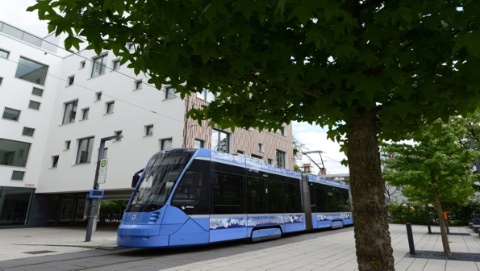
Joint field test proves the benefits of SiC technology in public transportation
Infineon has been a key player in the development of silicon carbide (SiC) technology and its qualification for use in rolling stock. For example, Infineon’s XHP 2 power modules based on SiC technology have proven their worth in a joint field test in Munich, creating benefits for manufacturers, rail operators and residents: A Siemens Avenio tram used for passenger rail service by the local German transport company MVG was equipped with XHP 2 power modules and tested in passenger service for a year, covering around 65,000 km. Siemens Mobility concluded that the use of power semiconductors based on silicon carbide made it possible to reduce the energy consumed by trams by ten percent.
At the same time, it was also possible to significantly reduce noise during operation. The tests were carried out under the European development and research project PINTA and are part of the European research initiative Shift2Rail, which aims to create a sustainable European rail system.
Higher energy efficiency thanks to silicon carbide
Implementing SiC in power modules for traction propulsion systems can also pose major challenges: In addition to an efficient and very robust SiC chip, packages that allow high switching speeds are also required, as well as interconnection technologies that enable a long service life. These are precisely the features offered by Infineon's power module: Since trains accelerate and decelerate frequently, the power cycles for semiconductors in rail applications are very demanding. Constant temperature fluctuations put stress on the interconnection technology. Infineon's .XT technology provides a solution to this challenge. The technology significantly increases the lifetime of power cycles and has been used successfully for years in other challenging applications such as wind turbines.
CoolSiC™ MOSFET chips in Infineon's XHP 2 power module enable low conversion losses while maintaining high reliability. The modules are the basis for increased energy efficiency. Infineon's XHP 2 package features low stray inductance, a symmetrical and scalable design and high current capacity. As a result, the package is ideally suited to SiC.


